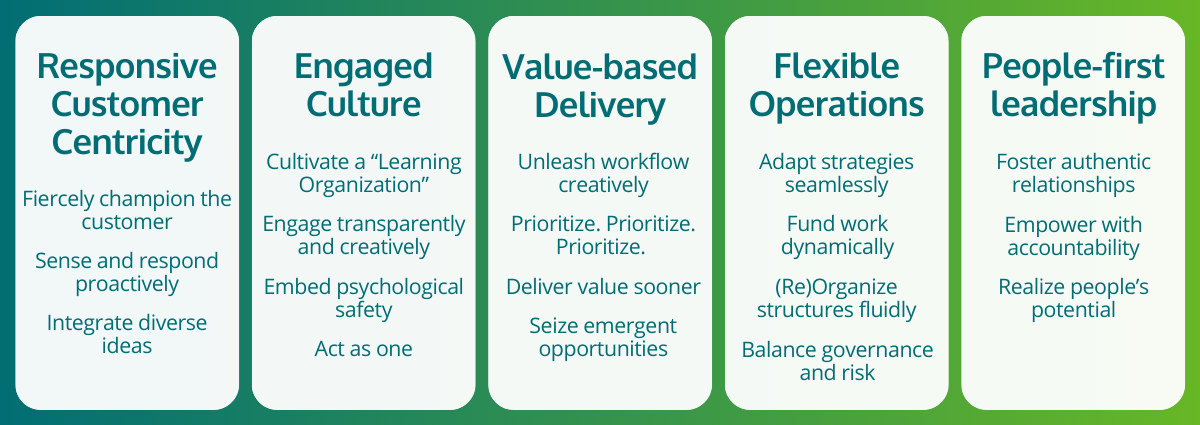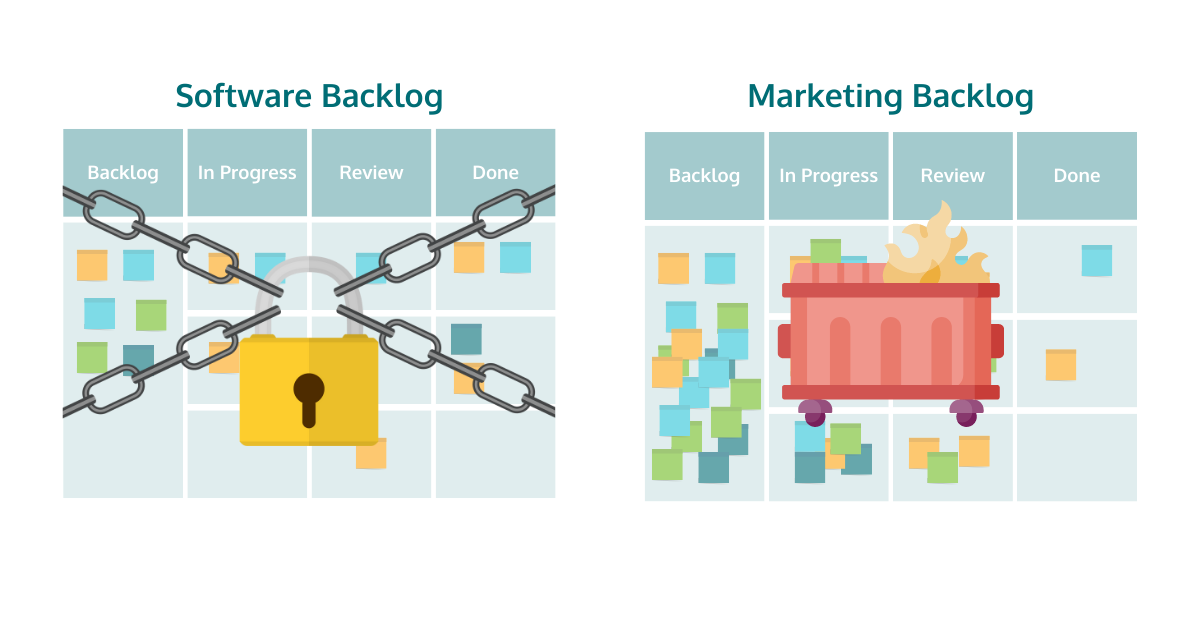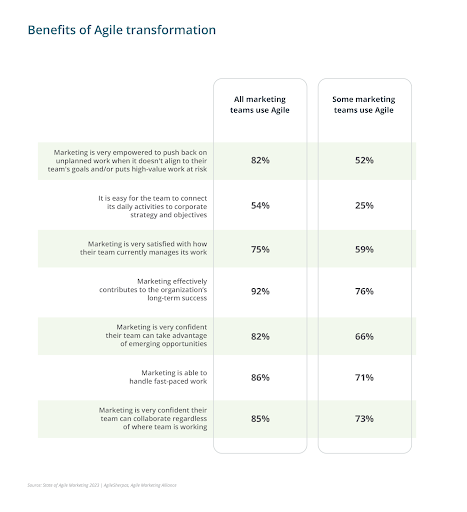Improve your Marketing Ops every week
Subscribe to our blog to get insights sent directly to your inbox.
Confront your process problems head on with a Sherpa by your side.
Explore support options that are tailored to meet you wherever you are on your climb.
Browse our pioneering Agile marketing courses
Learn from the stories of marketers already on the road to process improvement.
Featured Resource

State of Agile Marketing
Learn from 8 years of study on how marketers are increasing their agility.
Download Report
“We don’t do standups or sprints or anything, but our marketers are pretty agile already.”
If we’re using agile as a synonym for fast (or maybe even frantic), then this statement is often true. But it also often hides a deep-seated misunderstanding of what marketing actually looks like in Agile organizations.
Agile marketing isn’t just the ability to move fast and break things; it’s an end-to-end reconfiguration of the marketing function and its role in the business. When they show up in an Agile organization, marketing activities – from strategic planning to budgeting to daily execution – are almost unrecognizable compared to their traditional counterparts.
If you’re among those leaders who think Agile ways of working are just about doing regular old marketing a little faster, I want to let you in on some secrets.
Of course, to Agile organizations these aren’t secrets at all. They’re simply the way that marketing works. But for others these may be the jolt you need to finally up the agility of your marketing operations.
First of all, I should clarify what I mean when I say, “Agile organization.” Because just like “Agile marketing” doesn’t mean doing the same kind of marketing only faster, being an Agile organization doesn’t mean doing the same stuff you’ve always done only faster.
The Business Agility Institute is great at articulating the essence of Agile organizations via the Domains of Business Agility:

As you can see, organizations that have Agile embedded in their cores look, feel, and act differently than traditional ones. All of the components above are important, but we’re going to zero in on just a few to show how marketing evolves in these Agile organizations.
Now that we’ve had a high-level look at how the marketing function changes within an Agile organization, let’s get into some of the open secrets. The first is that Agile organizations highly value marketing’s contributions to strategic goals and objectives, especially because of their open line of communication to customers.
Stakeholders who rely on marketing to support their own initiatives listen to them and take their input into account. They don’t simply march in and demand landing pages and emails.
When marketing’s work is made visible, and their voices are heard during planning and reporting, it becomes clear how impactful this function can be. With this new level of transparency, marketing can move beyond stereotypical roles of order takers who build collateral on demand, or the “arts and crafts” department that complains about the logo being used wrong.
In this Agile organizational model, marketing gets a say in what they do. Sure they still deliver on internal requests, and of course sometimes they have to build slide decks for executive presentations. But the bulk of their work is theirs to direct.
Closely related to the above is that marketers in Agile organizations have the right to say no. Whether it’s because they’re fiercely championing the customer, protecting their priorities, or just pushing back on work that doesn’t need to be done, Agile marketers aren’t drowning under the compulsion to say yes to everything.
One of the best ways I can illustrate this is with a story of two backlogs. Agile software development teams have backlogs that capture the new features, bug fixes, upgrades, and so on that they plan to implement.

From time to time people within the organization will have feature requests, and they meet with a product owner (PO) or other leader to make them. Sometimes the PO accepts the request and puts it in the backlog to be actioned by the team at the right time. Other times the PO rejects it.
When the latter happens, the requestor has little recourse. They certainly can’t log into the code base and try to write the feature themselves.
The very idea of that is terrifying, and something that any development team would be appalled to imagine.
But what if we replace “software” with “marketing”?
In a traditional organization, if someone makes a request to marketing and the marketing owner (MO) declines it, the requestor may not take “no” for an answer. They might write an email to hundreds of customers themselves. They might throw together a one-pager to distribute at a conference. Or they might wrangle an online landing page builder to serve their purpose.
Those possibilities terrify marketers, but others shrug them off.
Not so in an Agile organization. Because everyone’s role is transparent, understood, and valued, this kind of subterfuge wouldn’t happen. Marketers have just as much right to turn down or de-priortize work as software developers, and in an Agile organization they do so.
Remember back in 2019, when Peloton spent $13 million on their holiday ad campaign? Here’s a reminder:
The feedback was, well, terrible. And to add insult to injury, Peloton’s stock price fell so precipitously following the ad’s release that some analysts estimated it lost over $1.5 billion.
That’s just one example of non-Agile marketing. And it was a very, very expensive example.
Agile marketing organizations, on the other hand, are far less likely to make these kinds of mistakes. Because they test, learn, and iterate rather than relying on traditional big-bang campaigns, they can identify the kind of red flags that would have put the above Peloton ad on the cutting room floor before it lost the company millions of dollars.
And it’s not just that risk goes down; costs do too.
For instance, we have one client who saved over $1 million in operating costs alone during the first three years of their Agile transformation.
Another marketing team saw the speed to market of their campaigns reduced by 75%.
The Standish Group reports that Agile projects and programs cost 3.6x less than traditional waterfall projects and programs.
So marketing within Agile organizations isn’t just faster, or more customer centric. It’s less expensive and less risky.
Before looking into the bonus secret we've prepared for you, why don't you check out the latest State of Agile Marketing report?
As you’ve no doubt noticed, I’ve spent this entire article talking about Agile organizations. Not Agile teams or Agile people. Agile organizations.
That’s because it’s been proven again and again that everything about Agile is better when everybody is using it.
The data from our 2023 State of Agile Marketing Report is just one proof point among many, but it shows how much more likely marketers are to enjoy the benefits of agility when all of them are Agile:
 And the same is true of an organization. The more people you pull into an Agile model, the better it is for everyone.
And the same is true of an organization. The more people you pull into an Agile model, the better it is for everyone.
Want to hear more from our CEO Andrea Fryrear? Subscribe to her weekly newsletter, Off the Trail, where she searches for operational excellence for marketers by going off the beaten path.

Andrea Fryrear is a co-founder of AgileSherpas and oversees training, coaching, and consulting efforts for enterprise Agile marketing transformations.
Subscribe to our blog to get insights sent directly to your inbox.
Subscribe to our blog to get insights sent directly to your inbox.